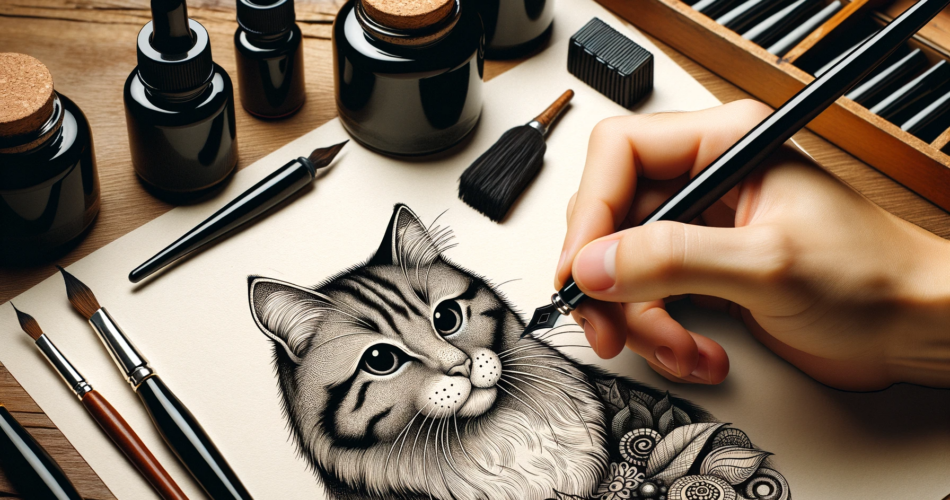Table of Contents
Introduction
Cats, with their sleek forms and enchanting eyes, have long been a favorite subject for artists.
But how do you ink a cat illustration to truly capture its elegance?
Whether you’re aiming for a playful doodle of a frisky kitten or a majestic portrayal of a regal lion, this guide will lead you through the nuances of inking feline figures.
Key Takeaways
Versatility of Feline Subjects: Cats, ranging from domesticated breeds to wild big cats, offer a rich canvas for artists. Their unique features and personalities make them captivating subjects.
Tool Selection: The choice of inking tools can profoundly influence the outcome. Both traditional tools like dip pens and brushes and digital tools like graphic tablets have their distinct advantages.
Mastering Basic to Advanced Techniques: Begin with the foundational steps, such as creating a light pencil sketch, before diving into advanced techniques like layering and detailing.
Capturing Realism: Achieving a realistic look, especially in fur and eye details, can elevate your cat illustrations. Techniques like layering and careful observation of references can assist in this.
Overcoming Challenges: Awareness of common pitfalls, like smudging or inaccurate fur depiction, and strategies to counteract them can ensure a polished final piece.
The Allure of Feline Subjects
The world of felines offers a vast spectrum, from domesticated house cats to the majestic big cats of the wild.
Their graceful movements and unique personalities make them captivating subjects for artists.
Choosing Your Inking Tools
- Traditional Inking Tools:
- Dip pens: Best for detailed whiskers and fine fur lines.
- Brushes: Create varied textures, perfect for fluffy feline coats.
- Fine liners: Ideal for consistent lines and detailed features.
- Digital Tools:
- Graphic tablets: Devices like the Wacom Intuos allow for precise strokes.
- Software: Programs such as Procreate or Adobe Photoshop offer specialized brushes for fur and textures.
Basic Steps to Ink a Cat
- Outline: Start with a light pencil sketch, capturing the cat’s basic shape and posture.
- Eyes: Cats’ eyes are expressive. Use smooth, consistent strokes for the outline and details.
- Fur Direction: Note the direction of the fur, especially around the face, legs, and tail.
Advanced Techniques for Realistic Fur and Features
- Layering: To achieve depth, use layering techniques, especially for long-haired breeds.
- Whiskers: Use a swift, confident stroke for whiskers to ensure they appear thin and sharp.
- Textures: For areas like the nose and paw pads, add texture to make them stand out.
Common Challenges and How to Overcome Them
- Avoiding Smudging: Especially with traditional tools, work from top to bottom and left to right (if right-handed) to prevent smudging.
- Getting Fur Right: Practice on scrap paper to master the look and feel of different fur types.
- Capturing Expressions: Cats have subtle expressions. Use references or observe real cats to capture them accurately.
Conclusion
Inking a cat is a delightful journey that combines the joy of artistry with the beauty of feline grace. With patience, practice, and the right techniques, your cat illustrations can truly come alive on paper.
FAQs on How to Ink a Cat
Q: Can I use colored inks for my cat illustrations?
A: Absolutely! Colored inks can add depth and dimension to your cat drawings, especially if you’re aiming for a stylized or vibrant look.
Q: I’m struggling with drawing different cat breeds. Any tips?
A: Different breeds have distinct features. Studying reference photos and understanding key differences, like ear shape or fur length, can be helpful.
Q: How can I achieve a soft fur effect with inking?
A: Soft fur can be depicted using lighter, closely spaced strokes. Layering and blending, especially in digital mediums, can also create a soft appearance.
Q: Any suggestions for inking big cats like lions or tigers?
A: Big cats have more defined musculature. Focus on their powerful build, and use references to accurately depict their unique fur patterns and mane (for lions).
Q: How can I prevent my ink from bleeding on paper?
A: Using high-quality, thick paper designed for inking or illustration can help. If using water-based inks, watercolor paper might be suitable.
Q: Are there any books or artists you recommend for mastering cat inking?
A: Many artists specialize in animal illustrations. Books like “The Art of Animal Drawing” by Ken Hultgren or following artists like Terryl Whitlatch can be insightful.



